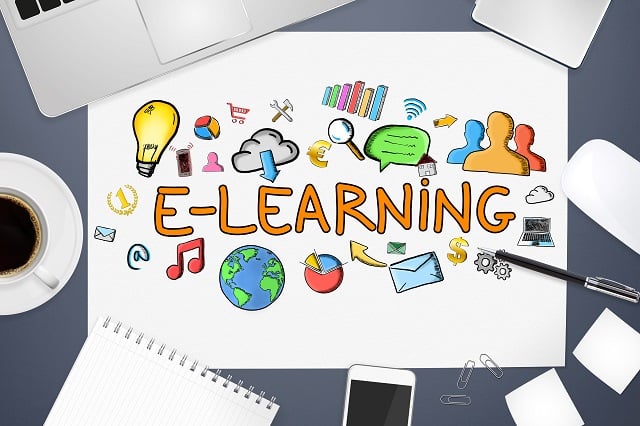
A lot of online learning is formulaic, dull, boring, and uninspiring and lacks different online interactions. Suppose you have been the victim of having to plod your way through what amounts to nothing more than a PowerPoint slideshow masquerading as an eLearning course. In that case, you will understand the feeling of wanting to do anything else but sit in front of a screen and have your brain slowly numbed into unconsciousness.
Undoubtedly, online learning has demonstrated its value to enterprises and the education sector. The ability to provide learning on any device, anywhere and anytime, is immensely powerful. However, people have different learning needs and learn at different paces and in different ways. It is important to include different types of online interactions in your courses. Here are some of the different forms of online interactions you can use to enhance your student or employee experience.
- Scenario-based learning
- Adaptive assessments
- Gamified scenarios
- Microlearning
- Question pools
- Practice with feedback
- Peer learning
There are several ways to engage your students or employees with different forms of online interaction. The rest of this article will cover all the different forms of interaction you can use online.
Scenario-Based Learning
Scenario-Based Learning (SBL) is a type of learning that helps users improve their decision-making skills by putting them in the shoes of someone else, offering a relevant and applicable user experience designed for maximum immersion.
This type of learning is very ‘sticky,’ a valuable method intended to create memorable experiences in the learner’s mind to help them recall and apply learned experiences.
The other great benefit of scenario-based learning is that it allows learners to make mistakes in the context of a practice scenario and receive feedback as necessary. Real learning takes place when you first attempt to apply the knowledge or skill you have gained.
Adaptive Assessments
Adaptive assessments are a type of assignment that is catered to the user’s skill level. Most people don’t recognize when they’re taking an adaptive assessment. One common application of this interaction is during the hiring process. A sophisticated algorithm manages the adaptation and navigates the learner down alternate paths depending on variables such as; time to answer, the complexity of the question, and correctness or completeness of the answer. For example, if a candidate answers a number of the initial questions incorrectly, the algorithm will deliver easier questions.
From the learner’s perspective, it helps balance the degree of easy and difficult questions. Still, the real merit of this approach is in the assigner’s ability to assess and modify exams based on the applicant’s skill level, demonstrating what the applicant has mastered and what they have yet to learn.

Gamified Scenarios
Gamification is a type of learning intended to make the experience feel more like a game. Over the years, this type of online interaction has become a powerful tool for educators, businesses, and sellers to engage their audience.
The main reason is that gamification enhances the learning experience by giving users a sense of accomplishment for demonstrating their knowledge or completing certain tasks and it actually taps into the same sort of chemical reward response (dopamine) that winning on the poker machines or winning in sport provides.
For example, take the app Bounty Tasker, which turns a simple to-do list into a full-fledged RPG adventure. At its core, it’s just a list of jobs you need to complete. Still, the added gamification aspects—defeating monsters, leveling up your character, and getting new loot—all contribute heavily to the app’s success in teaching people to be more productive and intrinsically motivate themselves to complete tasks.
Microlearning
Microlearning is a set of modules intended to avoid learner fatigue. The concept behind learner fatigue is that the brain stops being receptive to new information when overtasked. Microlearning is intended to address this concern, bundling topics into hyperfocused modules that generally take less than 20 minutes to complete (usually under 10).
These may also be in the form of activities that are completed daily. It’s the very essence of a bite-sized learning experience and is designed to help the learner focus without being overwhelmed by the broadness of a subject.
One of the simplest ways to incorporate microlearning is in a short video, ideally less than 10 minutes that covers a section of the topic, a key model or theory broken down into its simplest parts. Creating a video explainer in this way allows a person to access that one key piece of information at a later date without having to wade through a vast amount of information. Importantly, the video explainer can live outside your LMS and be available on a company portal/intranet, a website, or any other handy location where it can be referenced quickly and easily.
Question Pools
Educators use question pools in tests and surveys to create multiple subsets of questions that can be stored for repeated use.
Questions in a pool are recorded with feedback and metadata to discern learner responses and the accuracy of the questions. A faculty member/teacher/facilitator can create question pools by topic, type, or difficulty, and these pools can be used to generate assignments with randomized questions selected from the pool. This improves the variety of learning types, reduces repetition, and allows educators to customize their assessment experience.
For example, if you were building a compliance-based course on Health and Safety, you may create a whole bank of questions to draw from with 3 or 4 question alternatives for each key aspect that needs to be assessed. This ensures that the learner cannot simply guess the answer and then work out what they got wrong after the first attempt and which answer is correct by elimination.
Practice with Feedback
Practice with feedback allows educators to create a safe learning environment, improve knowledge, and shift to a focus on application. Practice with feedback is, in essence, a practice assignment on which the educator reviews and provides feedback.
Of course, this principle serves the simple purpose of helping learners understand the “why” behind an incorrect answer, correcting misunderstanding or misinterpretation, and redirecting learners toward a better understanding and application of the subject matter. Whilst similar to scenarios, this model looks at completing a full exercise rather than a scenario that usually focuses on drilling down on one aspect of knowledge.
Peer Learning
Peer learning is a type of learning experience that allows employees or group members to develop their skill sets and work among others to develop collective wisdom and reach learning goals.
Not only does peer learning help students positively impact each other, but it teaches learners how to study, develop, and apply knowledge without the help of an educator. Discussion groups are a great tool for Peer Learning as it provides the mechanism for a topic to be created or a question to be posed and ensures some interaction rules can be applied to govern the process. Additionally, this process allows the teacher/trainer to monitor the feedback being provided and, either individually or at a group level, steer the discourse or make corrections to inaccurate responses.

Final Thoughts
There are several different forms of online interaction, and they are not mutually exclusive from one another. These learning methods can enhance the learner experience, develop deep, applied learning principles, and help learners focus on their objectives.
Whether you’re an employer, educator, or group director, employing these forms of online interaction will help your learners engage with the material and apply what they are learning.
References
https://home.schoolcraft.edu/blackboardhelp/assessment-tools/question-pools
